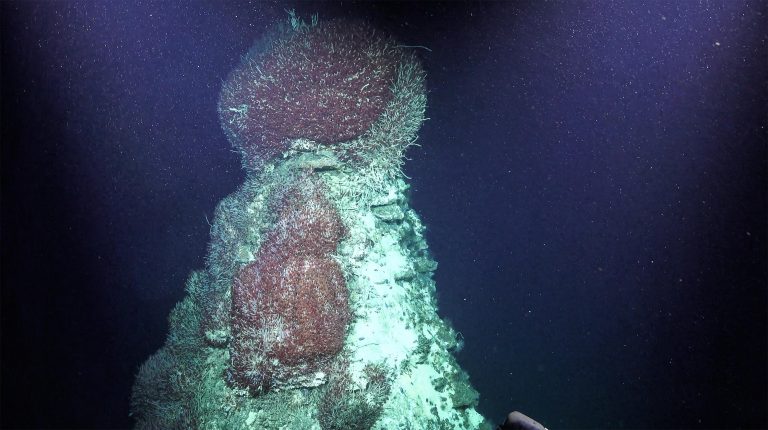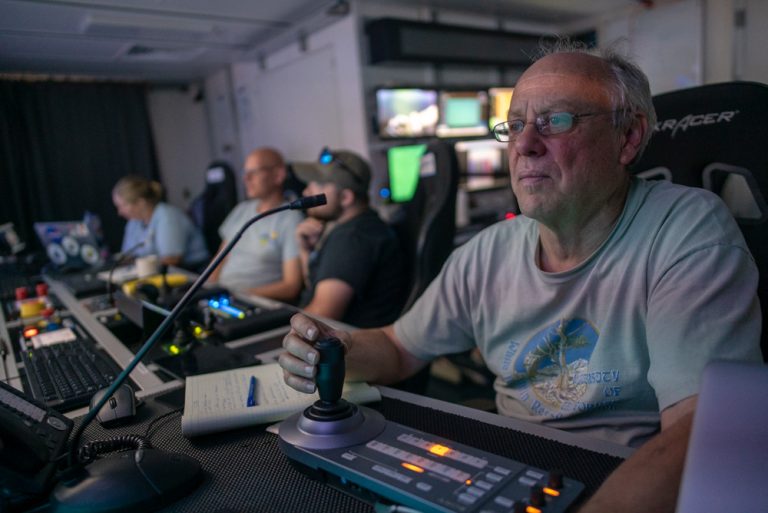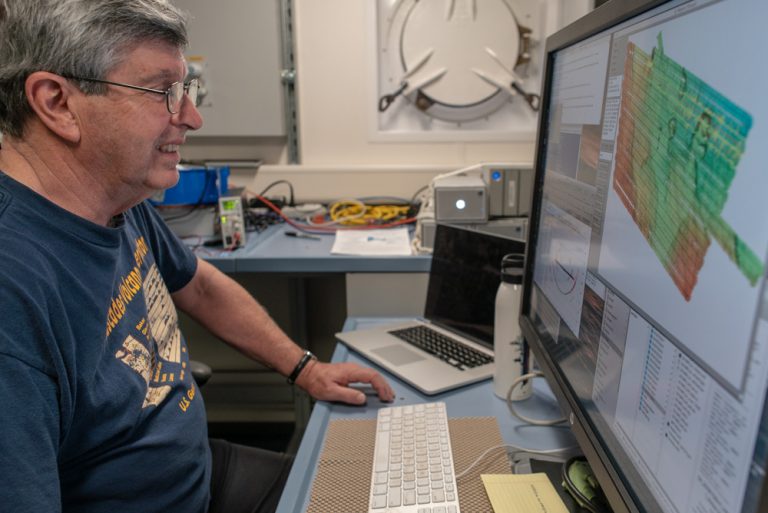Para una versión Español del este blog, por favor haga clic aquí.
Dr. Robert Zierenberg knows the Auka vent field better than anyone, so when ROV SuBastian landed in the position he had previously determined, he was not surprised. In fact, the spot was selected precisely because familiarity allows the team to trust navigation information and be certain that SuBastian is communicating its location accurately, enabling them to work more efficiently.
Dr. Zierenberg was nevertheless stunned by the view of the chimney before him. “Although I’ve seen this chimney a lot, I’ve never seen it in its entirety from a distance. With the other vehicles I’ve used to survey the area, you had to be closer to get a good look. SuBastian’s light system is such that you have the possibility to cast light over the objects from a greater distance, and what a beautiful view it is!” he said.
Besides verifying navigation accuracy, the area was also chosen because of the biological communities living there. The experts are mapping locations that will be important for the biologists that are joining Falkor for the second leg of the expedition. Sure enough, SuBastian’s cameras transmit images of countless tube worms and vast bacterial mats.

Holding Steady in Place of Change
During the morning Bridge meeting, Dr. Zierenberg explained that the chimney looked exactly how he remembered it. An interesting comment, since hydrothermal vent fields tend to be dynamic places, especially in areas with frequent volcanic eruptions. “I’m not surprised it didn’t change – it seems to be a very old and stable vent field,” the Chief Scientist continued. “I think we’re seeing its dying stages.”
The geochemical analysis of vent fluids collected from this field in 2015 reveal that in some stage of their travel through the subsurface, the fluids were much hotter than the 290° C measured when they were collected. In fact, the fluids were probably over 400 centigrade. Large mounds and chimneys built up from hydrothermal calcium carbonate offer another piece of evidence for a long lifetime: the active chimneys are only slowly depositing calcite and it takes a long time to build a mound 50 meters in diameter and more than 20 meters high.
The system may be dying, but it is doing so in geological time. It is not going to stop tomorrow, yet one of the aspects that researchers still do not have a clear picture of is how long hydrothermal systems can last.
The Pull of Mystery
Back in 2015, when Dr. Zierenberg accompanied the MBARI team that first discovered the Auka vent field, they directed the ROV pilots to go to a hill and try to quickly find some active hydrothermal chimneys in order to collect rock and fluid samples. It was the last dive of the cruise, and they only had 3 hours on bottom to find and sample a chimney in a place no human had seen before. The ship had to be in port by the next morning, so this opportunity was their only chance to collect samples. Thanks to the skills of the ROV pilots, they succeeded in getting both fluid and rock samples. The results are described in a paper written by the science party, which has just been accepted for publication.
One rock collected from a nearby hill on a subsequent dive proved to be quite interesting. It was composed of the mineral Baryte (a mineral consisting of barium sulphate), which is why the site is informally referred to as Baryte Hill. On shore, an examination of the rock using a microscope led Dr. Zierenberg to hypothesize that this sample was formed at a relatively low temperature seep site. An unusual and striking aspect that the sample has very high gold and silver concentrations, yet the concentration of several trace elements are different from any other Dr.Zierenberg has examined in more than 40 years of work on hydrothermal vents.
Black smokers can be enriched in gold, but they are also associated with copper, lead and zinc. This sample has none of those elements. “Everything in this rock looks to me like low temperature seeps, but it doesn’t look like low temperature from a black smoker, it looks like something else,” shares Dr. Zierenberg.
The team only knows two things for sure: the location they collected the sample, and that it came from a higher elevation up the hill. “It is highly unusual: not only does it not look like any seafloor deposit that I know of, it doesn’t look like any land based gold deposit that I know of,” says Dr. Zierenberg, explaining how the chemistry and mineralogy of this single sample is different. “I am intrigued by this because I don’t have a clue what’s up the hill where it came from, and I really want to know.” If everything goes well on the rest of the cruise, he will get the chance to find out!

Send the Sentinel
“When or if we have a dive in Baryte Hill remains to be seen,” says Dr. Zieremberg. “Even when I started writing this proposal more than 2 years ago, I was motivated by it and I really want to understand what this sample is and where it came from.” Still, the experts are looking for a needle in a haystack – surveying a big area. When researchers drive around with an ROV, they can only see a few meters in every direction, so it is very easy to fly right by some important discovery and never see it: this is why they want the best maps they can have.
Therefore, AUV D Allan B’s first mission was to scout Baryte Hill. The mission ran smoothly, but when the team got the data back, it was an extremely poor data set: big sources of interference (noise) were scattered all around. Luckily, the team was able to “clean” it and the data became usable. In spite of having an auspicious resolution to all his hard work, marine geologist Dave Clague sighed. The effort is huge, very methodical and time consuming. “We’re going to have a good map.” He smiles – “It’s always very ugly before we make it pretty.” Their determination is beginning to pay off, the AUV’s map is beginning to take shape, and promising features are taking the stage.


